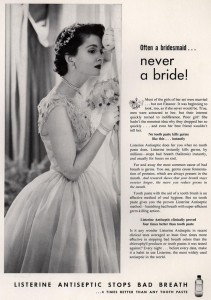 You could be an attorney defending an unpopular client, a marketer trying to induce consumers to try a new and better product, a writer attempting to enlighten readers to a better point of view or a community leader endeavoring to improve conditions in your area. All face the same challenge: It’s often very hard to get people to change their minds and adopt a new point of view.
You could be an attorney defending an unpopular client, a marketer trying to induce consumers to try a new and better product, a writer attempting to enlighten readers to a better point of view or a community leader endeavoring to improve conditions in your area. All face the same challenge: It’s often very hard to get people to change their minds and adopt a new point of view.
But why? Don’t humans want justice, superior products, more accurate knowledge and better living conditions? Don’t we yearn to know the truth? For the most part, yes. And yet, as Mark Twain observed, “A lie can travel halfway around the world while the truth is putting on its shoes.” Right or wrong, ideas spread quickly and once people have adopted them most hesitate to give them up.
Research shows why
 Social psychologists examined the reasons why people are so reluctant to accept new viewpoints. One reason became apparent in a series of studies starting in 1959. Eminent social psychologist Dr. Elliot Aronson explains that research began in a southern town deeply divided over racial segregation. Most today clearly recognize the evils of apartheid, but in 1959 it was a burning issue, particularly in the South.
Social psychologists examined the reasons why people are so reluctant to accept new viewpoints. One reason became apparent in a series of studies starting in 1959. Eminent social psychologist Dr. Elliot Aronson explains that research began in a southern town deeply divided over racial segregation. Most today clearly recognize the evils of apartheid, but in 1959 it was a burning issue, particularly in the South.
Researchers selected people with strong feelings for or against segregation. Then they presented a series of arguments on both sides of the issue. Some were plausible, others were lame. A survey on the points each recalled was telling. People remembered the logical arguments supporting their position and the illogical arguments that backed the opposing view.
A number of follow up studies produced similar results. The answer was clear. It showed why strong beliefs are so hard to change. It revealed why negative pretrial publicity can make a fair trial difficult to obtain. People ignored or quickly forgot points that might prove their opinions wrong. They focused on the opposition’s lame arguments because these strengthened their positions. This phenomenon is called Confirmation Bias. Finding the right answer took a back seat to proving they were right. The highly respected Dr. Aronson explains:
During the past half-century, social psychologists have discovered that one of the most powerful determinants of human behavior stems from our need to preserve a stable, positive self-image. Most of us want to believe that we are reasonable, decent folks who make wise decisions, do not behave immorally and have integrity.
Most show a strong need to protect their self-image. The idea that we were wrong makes us uncomfortable. Thus, when confronted with factual information that might show us mistaken or foolish, we automatically tend to ignore or dismiss it, focusing instead on any shred of evidence that might prove us right.
 One study found that smokers who tried but failed to quit were least likely to recognize the hazards of smoking. Acknowledging that their persistent habit could kill them and their loved ones was too difficult to face. So, with heads firmly in the sand, they saw no danger and continued to smoke.
One study found that smokers who tried but failed to quit were least likely to recognize the hazards of smoking. Acknowledging that their persistent habit could kill them and their loved ones was too difficult to face. So, with heads firmly in the sand, they saw no danger and continued to smoke.
Timing proves crucial
Research on changing minds uncovered another critical factor: timing. Studies show that at certain periods in a person’s life, their minds are far more open to new ideas than at other times. During childhood, early adulthood and in old age people tend to be open-minded. Opinions and beliefs adopted “when the concrete is wet” may become strongly entrenched once it “dries.”
 Consider a groundbreaking study conducted with students from Vermont’s Bennington College. During the 1930s and early 1940s, Bennington students were primarily women from wealthier, more politically conservative families. In contrast, many of the college’s professors were leftists. Continual exposure to their ideas molded the opinions of juniors and seniors.
Consider a groundbreaking study conducted with students from Vermont’s Bennington College. During the 1930s and early 1940s, Bennington students were primarily women from wealthier, more politically conservative families. In contrast, many of the college’s professors were leftists. Continual exposure to their ideas molded the opinions of juniors and seniors.
The influence of professors and upperclassmen was strong and its effects long-lasting. Bennington women became much more liberal than others from the same social background. Some fifty years later, in the 1984 presidential election, Bennington alumnae in their 70s voted Democratic by a 3 to 1 margin while, nationwide, the same percentage of college educated women in that age group voted Republican. Social psychologist David Myers, PhD noted, “Their views embraced at an impressionable time had survived a lifetime of wider experience.”
Takeaways
 It’s very difficult to make a comfortable living telling others that they are wrong. Confirmation bias is far too strong in most minds to permit that approach to work. Instead, before telling people that your data or position is better than theirs let them off the emotional hook. It’s no accident that in Confessions of An Advertising Man, legendary marketer David Ogilvy listed “announcing”, “introducing” and “improvement” among the most persuasive words his agency had ever found.
It’s very difficult to make a comfortable living telling others that they are wrong. Confirmation bias is far too strong in most minds to permit that approach to work. Instead, before telling people that your data or position is better than theirs let them off the emotional hook. It’s no accident that in Confessions of An Advertising Man, legendary marketer David Ogilvy listed “announcing”, “introducing” and “improvement” among the most persuasive words his agency had ever found.
One can improve an old idea or introduce a new one without threatening prospective buyers’ or jurors’ self-esteem. Wise copywriters and lawyers will find ways to avoid making their audience feel threatened by the information they want to impart. An attorney could, for example, acknowledge the mistakes made by an unpopular client, but point out that they are not responsible for the offense for which they have been charged. Admitting their client’s wrongs can increase the advocate’s own credibility while giving jurors an acceptable reason for their negative feelings about the defendant. It allows member of the jury to dislike the accused without holding them liable for the charge at hand.
Timing Takeaway
Timing clearly plays a crucial role for communicators. This is particularly important if communicating with adults from 28 to 68. As Dr. Theodore Newcomb’s Bennington College study and other research reveals, worthwhile ideas and products presented to young adults (18-22) may well be adopted for a lifetime. (Parents and students will thus want to consider atmosphere and culture as well as program quality and facilities as key factors when choosing a college). Research at Stanford shows that as people approach the end of their lives, they may also become more open to new thoughts.
 Understanding how people think is vital if one is going to change their minds. This is why social psychology studies can prove so helpful in determining communication strategies. Marketing researchers provide enlightening answers. But that information is proprietary; no one wants to let their competitors know what tactics really work.
Understanding how people think is vital if one is going to change their minds. This is why social psychology studies can prove so helpful in determining communication strategies. Marketing researchers provide enlightening answers. But that information is proprietary; no one wants to let their competitors know what tactics really work.
Social psychologists, on the other hand, explore the same vital topics on influencing large groups of people. Their studies are carefully examined by experts and, if found sound and useful, are published and widely available. If the principles they uncover survive this process and are extensively replicated, they become highly useful tools for influential communicators. Employing them well can help change people’s minds for the better.
Larry Rondeau is a marketing strategist and business writer seeking marketing opportunities or freelance writing work. Email him at larryrondeau@cox.net.









 ding why people buy your product or service. It may be for its utility – what it does to help them. Or it may be how it makes them feel – directly or indirectly. Understanding this is critical in effectively marketing your product.
ding why people buy your product or service. It may be for its utility – what it does to help them. Or it may be how it makes them feel – directly or indirectly. Understanding this is critical in effectively marketing your product.










